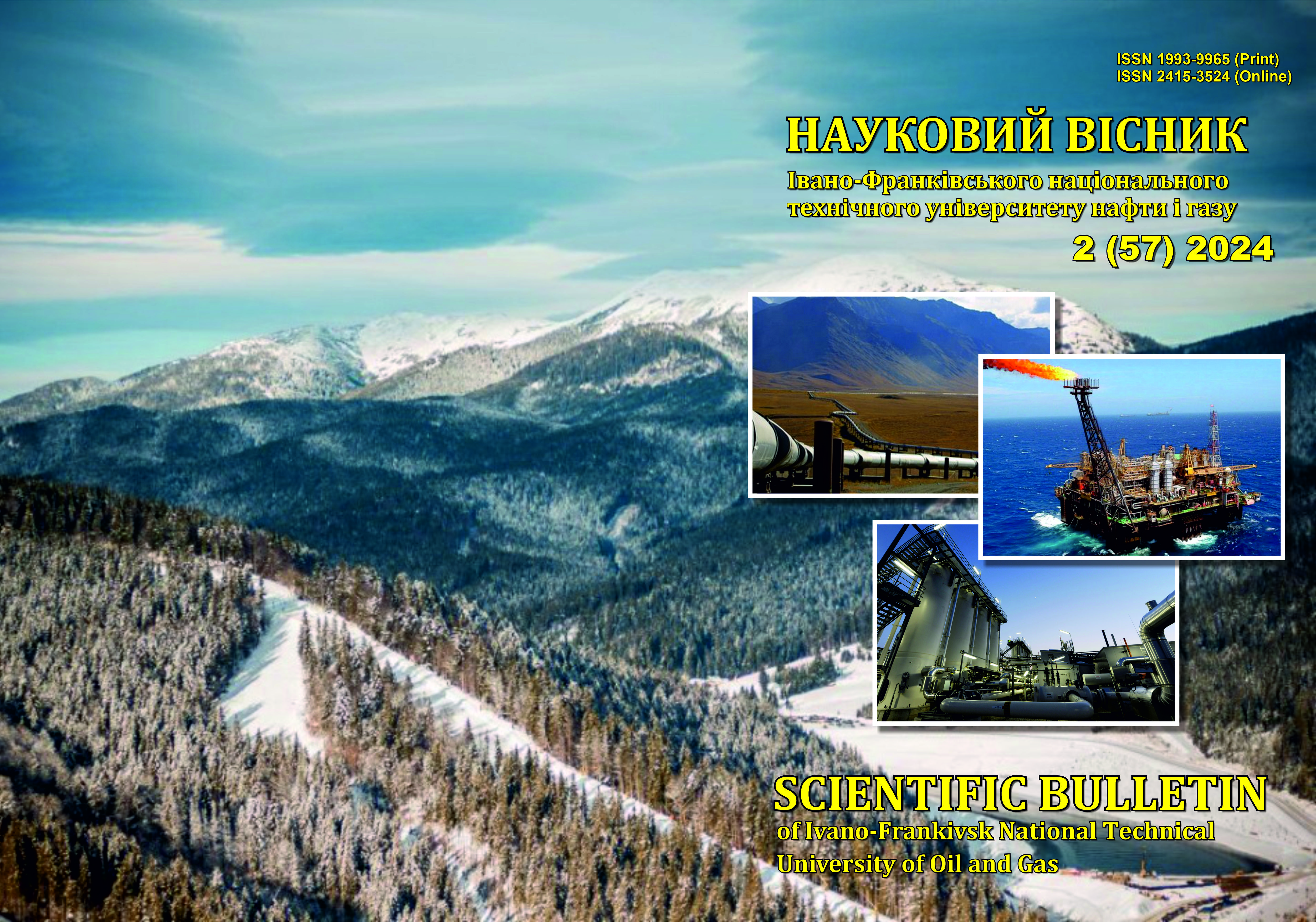DEVELOPMENT OF A NEW FRICTION DAMPER BASED ON AN OPEN SHELL FOR MODERN DRILLING SHOCK ABSORBERS
DOI:
https://doi.org/10.31471/1993-9965-2024-2(57)-25-33Keywords:
vibration protection, drilling shock absorber, open shell, weakly compressive filler, frictional interaction, shell damper.Abstract
Modern drilling technologies for the construction of deep oil, gas and geothermal wells require effective solutions to reduce vibration loads on drill bits and drilling rigs. The study presents an innovative friction damper for drilling shock absorbers, developed on the basis of an open thin-walled shell. The damper consists of a barrel, two spring sections and a friction module, including a shell cut along the generatrix and a weakly compressible elastic filler. The spring sections and the friction module operate in parallel, providing a total increase in holding capacity, with each of these links taking up a share of the external load proportional to its own stiffness. The proposed device demonstrates good damping characteristics, is capable of operating under high operational loads and at the same time has compact transverse dimensions. Under non-monotonic loading of such a shock absorber, due to the contact interaction of the filler with the open shell, part of the energy supplied to the system will be dissipated. In other words, in response to the action of an external non-monotonic load, the phenomenon of structural hysteresis occurs in the friction module of the damper. To assess the rigidity and damping characteristics of the new friction damper, experimental diagrams of its deformation are constructed. Based on these diagrams, based on the known load history, it is possible to predict the behavior of the vibration protection system under consideration at any time after the start of the loading process. The article also considers the design features of a drilling shock absorber built on the basis of the developed friction damper.
Downloads
References
Jaisee S., Yue F., & Ooi Y. H. A state-of-the-art review on passive friction dampers and their applications. Engineering Structures. 2021. Vol. 235, 112022. https://doi.org/10.1016/j.engstruct.2021.112022
Dutkiewicz M., Velychkovych A., Shatskyi I., Shopa V. Efficient Model of the Interaction of Elastomeric Filler with an Open Shell and a Chrome-Plated Shaft in a Dry Friction Damper. Materials. 2022. 15(13). 4671. https://doi.org/10.3390/ma15134671
Balaji P. S., Karthik Selva Kumar K. Applications of Nonlinearity in Passive Vibration Control: A Review. Journal of Vibration Engi-neering & Technologies. 2020. https://doi.org/10.1007/s42417-020-00216-3
Gao S., Wang Y. An Evaluation Method for Dry Friction Damping of Ring Damper in Gas Turbine Engines under Axial Vibration. Aerospace. 2021. 8(10). 302. https://doi.org/10.3390/aerospace8100302
He, B., Ouyang, H., Ren, X., & He, S. Dynamic Response of a Simplified Turbine Blade Model with Under-Platform Dry Friction Dampers Considering Normal Load Variation. Applied Sciences. 2017. 7(3), 228. https://doi.org/10.3390/app7030228
Pesek, L., Pust, L., Snabl, P., Bula, V., Hajzman, M., Byrtus, M. Dry-Friction Damping in Vibrating Systems, Theory and Application to the Bladed Disc Assembly. In: Jauregui J. (eds) Nonlinear Structural Dynamics and Damping. Mechanisms and Machine Science. 2019, 69. Springer, Cham. https://doi.org/10.1007/978-3-030-13317-7_6
Huang, Z., Tan, J., Liu, C., & Lu, X. Dy-namic Characteristics of a Segmented Supercritical Driveline with Flexible Couplings and Dry Friction Dampers. Symmetry, 2021. 13(2), 281. https://doi.org/10.3390/sym13020281
Wahad, H.S., Tudor, A., Vlase, M., Cer-bu, N., & Subhi, K.A. (2017). The effect of friction in coulombian damper. IOP Conf. Series: Materials Science and Engineering, 174, 012021. https://doi.org/10.1088/1757-899X/174/1/012021
Hareen, C. B. V., & Mohan, S. C. Energy-based seismic retrofit and design of building frames with passive dampers. Engineering Structures, 2022. 250, 113412. https://doi.org/10.1016/j.engstruct.2021.113412
Aydin, E., Öztürk, B., & Dutkiewicz, M. Analysis of efficiency of passive dampers in multistorey buildings. Journal of Sound and Vibration, 2019. 439, 17–28. https://doi.org/10.1016/j.jsv.2018.09.031
Paronesso, M., Lignos, D.G. Ex-perimental study of sliding friction damper with composite materials for earthquake resistant structures. Engineering Structures, 2021. 248, 113063. https://doi.org/10.1016/j.engstruct.2021.113063
Rathee, R. (2023). Numerical modeling and simulation of friction models for mechanical systems: A brief review. Materials Today: Proceedings. https://doi.org/10.1016/j.matpr.2022.12.185
Shatskyi, I., Popadyuk, I., & Velych-kovych, A. (2018). Hysteretic properties of shell dampers. In Dynamical Systems in Applications, Proceedings of the DSTA 2017, Lodz, Poland, 11–14 December 2017; Awrejcewicz, J., Ed.; Springer: Cham, Switzerland, P. 343–350. https://doi.org/10.1007/978-3-319-96601-4_31
Barsotti, R., Bennati, S., & Migliaccio, G. (2024). Non-Linear Dynamics of Simple Elastic Systems Undergoing Friction-Ruled Stick–Slip Motions. Civil Eng, 5(2), 420–434. https://doi.org/10.3390/civileng5020021
Ferrotto, M. F., & Cavaleri, L. (2022). Variable Friction Dampers (VFD) for a modulated mitigation of the seismic response of framed structures: Characteristics and design criteria. Proba-bilistic Engineering Mechanics, 103375. https://doi.org/10.1016/j.probengmech.2022.103375
Lan, X., Wei, G., & Zhang, X. (2024). Study on the Influence and Optimization Design of Viscous Damper Parameters on the Damping Effi-ciency of Frame Shear Wall Struc-ture. Buildings, 14(2), 497. https://doi.org/10.3390/buildings14020497
Velychkovych, A., Bedzir, O., & Shopa, V. (2021). Laboratory experimental study of contact interaction between cut shells and resilient bodies. Engineering Solid Mechanics, 9(4), 425–438. https://doi.org/10.5267/j.esm.2021.5.003
Wang, Q., Shen, H., Zhang, Z., & Qian, H. (2023). Mechanical Behaviors of a Buckling-Plate Self-Centering Friction Damper. Buildings, 13(2), 440. https://doi.org/10.3390/buildings13020440
Bazaluk, O., Slabyi, O., Vekeryk, V., Velychkovych, A., Ropyak, L., & Lozynskyi, V. (2021). A Technology of Hydrocarbon Fluid Production Intensification by Productive Stratum Drainage Zone Reaming. Energies, 14(12), 3514. https://doi.org/10.3390/en14123514
Velichkovich, A.S., & Dalyak, T.M. (2015). Assessment of stressed state and perfor-mance characteristics of jacketed spring with a cut for drill shock absorber. Chem. Pet. Eng., 51, 188–193. https://doi.org/10.1007/s10556-015-0022-3
Tian, J., Yang, Z., Li, Y., Yang, L., Wu, C., Liu, G., & Yuan, C. (2016). Vibration analysis of new drill string system with hydro-oscillator in horizontal well. Journal of Mechanical Science and Technology, 30(6), 2443–2451. https://doi.org/10.1007/s12206-016-0504-z
Velychkovych, A., Petryk, I., & Ropyak, L. (2020). Analytical Study of Operational Properties of a Plate Shock Absorber of a Sucker-Rod String. Shock and Vibration, 2020, 1–7. https://doi.org/10.1155/2020/3292713
Dong, G., & Chen, P. (2016). A Review of the Evaluation, Control, and Application Techno-logies for Drill String Vibrations and Shocks in Oil and Gas Well. Shock and Vibration, 2016, 1–34. https://doi.org/10.1155/2016/7418635
Velichkovich, A., Dalyak, T., & Petryk, I. (2018). Slotted shell resilient elements for drilling shock absorbers. Oil & Gas Science and Techno-logy – Revue d’IFP Energies nouvelles, 73, 34. https://doi.org/10.2516/ogst/2018043
Velichkovich, A. S., Popadyuk, I. I., & Shopa, V. M. (2011). Experimental study of shell flexible component for drilling vibration damping devices. Chemical and Petroleum Engineering, 46(9-10), 518–524. https://doi.org/10.1007/s10556-011-9370-9
Dutkiewicz, M., Golebiowska, I., Shatskyi, I., Shopa, V., Velychkovych, A. (2018). Some aspects of design and application of inertial dampers. MATEC Web of Conf., 178, 06010. https://doi.org/10.1051/matecconf/201817806010
Shats’kyi, I. P., Shopa, V. M., & Velychkovych, A. S. (2021). Development of Full-Strength Elastic Element Section with Open Shell. Strength of Materials, 53(2), 277–282. https://doi.org/10.1007/s11223-021-00286-y
Zuo, Y., & Wu, X. (2017). A comparative study of four rod load reduction techniques for deep-rod pumping. Journal of Petroleum Explo-ration and Production Technology, 8(2), 475–483. https://doi.org/10.1007/s13202-017-0367-6
Velichkovich, A. S. (2005). Shock Absorber for Oil-Well Sucker-Rod Pumping Unit. Chemical and Petroleum Engineering, 41(9-10), 544–546. https://doi.org/10.1007/s10556-006-0015-3
Yongwang, L., Hongning, Z., Yixiang, N., Guojun, L., Wentao, L., & Yiwu, L. (2023). Experiment on the influence of downhole drill string absorption & hydraulic supercharging device on bottom hole WOB fluctuation. Energy Reports, 9, 2372–2378. https://doi.org/10.1016/j.egyr.2023.01.047
Aarsnes, U. J. F., & van de Wouw, N. (2019). Effect of shock subs on self-excited vibra-tions in drilling systems. Journal of Petroleum Science and Engineering, 181, 106217. https://doi.org/10.1016/j.petrol.2019.106217
Sharmin, T., Khan, N. R., Akram, M. S., & Ehsan, M. M. (2023). A State-of-the-art Review on for Geothermal Energy Extraction, Utilization, and Improvement Strategies: Conventional, Hybridized, and Enhanced Geothermal Sys-tems. International Journal of Thermofluids, 100323. https://doi.org/10.1016/j.ijft.2023.100323
Landar, S., Velychkovych, A., Ropyak, L., & Andrusyak, A. (2024). A Method for Applying the Use of a Smart 4 Controller for the Assessment of Drill String Bottom-Part Vibrations and Shock Loads. Vibration, 7(3), 802-828. https://doi.org/10.3390/vibration7030043
Yuan, X., Tian, T., Ling, H., Qiu, T., & He, H. (2019). A Review on Structural Development of Magnetorheological Fluid Damper. Shock and Vibration, 2019, article ID 1498962. https://doi.org/10.1155/2019/1498962
Zhanwen, W., Tianming, Z., Zutao, Z., Yanping, Y., & Yujie, L. (2020). A high-efficiency regenerative shock absorber considering twin ball screws transmissions for application in range-extended electric vehicles, Energy and Built Environment, 1(1), 36–49. https://doi.org/10.1016/j.enbenv.2019.09.004
Landar, S., Velychkovych, A., & Mykhailiuk, V. (2024). Numerical and analytical models of the mechanism of torque and axial load transmission in a shock absorber for drilling oil, gas and geothermal wells. Engineering Solid Mechanics, 12(3), 207–220. https://doi.org/10.5267/j.esm.2024.3.002
Downloads
Published
How to Cite
Issue
Section
License
Авторські права....


1.png)

















